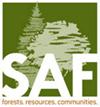应用红外光谱鉴定亚马逊雨林的倒塌树木(肉豆蔻属)
IF 1.5
4区 农林科学
Q2 FORESTRY
引用次数: 0
摘要
红外光谱带有所谓的植物指纹,这一特征有助于从综合角度识别木材。我们对傅立叶变换近红外光谱仪(FT-NIRS)在亚马逊雨林(肉豆蔻科)天然倒伏树木分类鉴定中的潜在用途进行了评估。对在森林地面(巴西亚马孙)发现的树木进行了调查,并选择了 8 棵树木进行研究。从树干上取下材料,根据木质部结构进行解剖鉴定,并获取近红外光谱(10,000 至 4,000 cm-1)。总共收集了 1,080 个光谱,并用于多元分析。近红外区域的吸收带和化学计量学(校准模型)被用来解释光谱,光谱显示了属和种一级的相似性趋势。线性判别分析(LDA)能够区分 Iryanthera ulei 和 Virola(5 个物种),而在现场它们被误认为是单一物种(Virola sp.)。化学计量模型(LDA 7 和 14)得出的结果的准确性表明,近红外光谱技术具有稳健性,可作为一种新工具,用于对热带森林中难以识别的植物材料进行综合分类,并能快速、安全地进行多项测试分析。研究意义:由于在野外采集时缺乏花、果实和叶子,因此对热带森林地面上发现的天然倒伏树木进行分类鉴定相当复杂。傅立叶变换近红外光谱仪证明了其区分肉豆蔻科倒伏树木木材样本的能力。化学计量模型成功地区分了样本,这些样本在野外被错误地归类为 Virola sp.这一单一物种。我们的研究强调了它在解决分类错误和进行分类鉴定方面的功效。本文章由计算机程序翻译,如有差异,请以英文原文为准。
Application of Infrared Spectroscopy in the Identification of Fallen Trees from the Amazon Rainforest (Myristicaceae)
The infrared spectrum carries the so-called fingerprint of a plant, a characteristic that can help the identification of wood from an integrative perspective. Fourier-transform near-infrared spectroscopy (FT-NIRS) was evaluated for its potential use in the taxonomic identification of natural fallen trees from the Amazon rainforest (Myristicaceae). Trees found on the forest floor (Amazonas, Brazil) were surveyed, and eight individuals were selected for the study. The material was removed from the trunk for anatomical identification based on xylem structure and obtaining NIR spectra (10,000 to 4,000 cm-1). A total of 1,080 spectra were collected and used in the multivariate analysis. Absorption bands in the NIR region and chemometrics (calibration models) were used to interpret the spectra, which indicated similarity trends at the genus and species levels. Linear discriminant analysis (LDA) was able to differentiate Iryanthera ulei and Virola (five species), which were misclassified in the field as a single species (Virola sp.). The accuracy of the results obtained by chemometric models (LDA 7 and 14) indicates the robustness of NIR spectroscopy, which can be used as a new tool in the integrative taxonomy of plant material from tropical forests that are difficult to identify and can analyzing many tests quickly and securely. Study Implications: The taxonomic identification of natural fallen trees found on the floor of tropical forests is quite complex given the lack of flowers, fruits, and leaves in field collection. Fourier-transform near-infrared spectroscopy demonstrated its capability to distinguish between wood samples from fallen trees belonging to the Myristicaceae family. The chemometric model successfully discriminated the samples, which had been erroneously lumped together in the field under the single species designation of Virola sp. This technique has been previously overlooked for providing differentiation. Our study highlights its efficacy to address misclassifications and allow taxonomic identification.
求助全文
通过发布文献求助,成功后即可免费获取论文全文。
去求助
来源期刊

Forest Science
农林科学-林学
CiteScore
2.80
自引率
7.10%
发文量
45
审稿时长
3 months
期刊介绍:
Forest Science is a peer-reviewed journal publishing fundamental and applied research that explores all aspects of natural and social sciences as they apply to the function and management of the forested ecosystems of the world. Topics include silviculture, forest management, biometrics, economics, entomology & pathology, fire & fuels management, forest ecology, genetics & tree improvement, geospatial technologies, harvesting & utilization, landscape ecology, operations research, forest policy, physiology, recreation, social sciences, soils & hydrology, and wildlife management.
Forest Science is published bimonthly in February, April, June, August, October, and December.
 求助内容:
求助内容: 应助结果提醒方式:
应助结果提醒方式:


